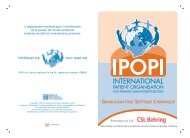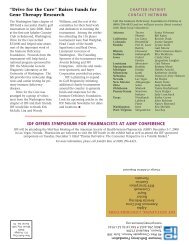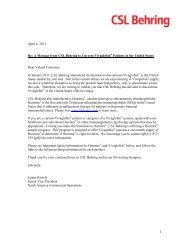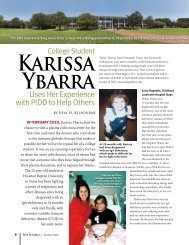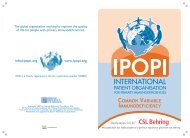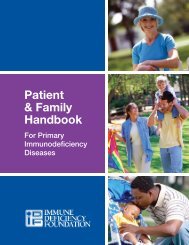Stem Cell Therapy and Gene Therapy
Stem Cell Therapy and Gene Therapy
Stem Cell Therapy and Gene Therapy
You also want an ePaper? Increase the reach of your titles
YUMPU automatically turns print PDFs into web optimized ePapers that Google loves.
<strong>Stem</strong> <strong>Cell</strong> <strong>Therapy</strong> <strong>and</strong> <strong>Gene</strong> <strong>Therapy</strong><br />
(Hematopoietic <strong>Stem</strong> <strong>Cell</strong> Transplantation continued)<br />
immune function that they are incapable of rejecting a<br />
graft <strong>and</strong> do not require conditioning before HSCT.<br />
A similar situation occurs when the recipient’s bone<br />
marrow is full of its own, defective stem cells <strong>and</strong> the<br />
HSC cannot find anyplace to establish themselves. This<br />
is called “failure of engraftment.” To prevent this,<br />
chemotherapy may be given to reduce the number of<br />
defective HSC in the recipient’s bone marrow in order to<br />
“make room” for the new HSC to engraft.<br />
Although the chemotherapy treatment prevents the host<br />
from rejecting the transplanted HSCs, it may cause<br />
serious side effects. These include transient loss of all of<br />
the cells of the bone marrow so the patient is very<br />
susceptible infections, anemia (low RBC) <strong>and</strong> bleeding<br />
problems due to low platelets. Chemotherapy also may<br />
cause severe blistering of the mouth or other mucous<br />
membranes that makes getting adequate hydration <strong>and</strong><br />
nutrition very difficult. It is because of these serious<br />
complications that HSCT is reserved for those patients<br />
with the most severe immune defects.<br />
The second obstacle that must be overcome for the<br />
transplant to be successful is Graft versus Host Disease<br />
(GVHD). This occurs when the mature T-cells from the<br />
donor or which develop after the transplant, perceive<br />
the host’s tissues as foreign <strong>and</strong> attack these tissues. To<br />
prevent GVHD, medications to suppress inflammation<br />
<strong>and</strong> T-cell activation are used. These medications may<br />
include steroids, cyclosporine <strong>and</strong> other drugs.<br />
In order to prevent some of these potential obstacles, it<br />
is important to try to identify a “matched” donor. A<br />
matched donor is one whose Human Leukocyte<br />
Antigens (HLA) are the same as those of the recipient.<br />
Selecting a Donor<br />
HLA are tissue types. Each of us has our own<br />
collection of HLA antigens on our cells including the<br />
cells of our immune system <strong>and</strong> bone marrow, as well<br />
as on cells in most other tissues <strong>and</strong> organs. The<br />
exact structure of these HLA antigens is determined<br />
by a series of genes clustered on the sixth (6th)<br />
human chromosome. Compatibility of HLA is very<br />
important to determine the chance of successful<br />
engraftment while keeping the risk of GVHD low.<br />
There are many different variants for each of these<br />
HLA genes in humans. The combination of HLA alleles<br />
of each individual is relatively unique. However, since<br />
the HLA genes are closely clustered on chromosome<br />
6, they are usually inherited as a single unit.<br />
Therefore, the chance that an individual’s brother or<br />
sister shares the same HLA alleles is relatively high.<br />
There is a 1 in 4 chance that any sibling could be a<br />
perfect match for the patient. Unfortunately, due to the<br />
laws of probability <strong>and</strong> the fact that most families have a<br />
limited number of children, fewer than 25% of patients<br />
have a sibling who is a “match.” Therefore, there has<br />
been a major effort to develop alternative methods to<br />
offer the possibility of a transplant to patients who do<br />
not have a matched donor in their own family.<br />
One alternative is to try to find a suitable matched donor<br />
through one of the worldwide computer-based registries<br />
of individuals who have volunteered to serve as bone<br />
marrow donors. The National Marrow Donor Program in<br />
the U.S. has listings of hundreds of thous<strong>and</strong>s of<br />
individuals who have provided a blood sample to have<br />
their HLA type measured. Similar registries are present<br />
in many countries around the world.<br />
IDF Patient & Family H<strong>and</strong>book | 154








